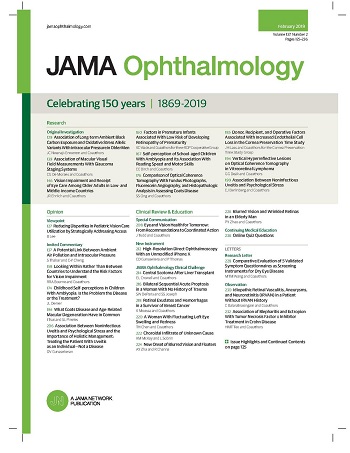与使用深度学习的3D未分割光学相干断层扫描卷相关的视神经萎缩状况
IF 9.2
1区 医学
Q1 OPHTHALMOLOGY
引用次数: 0
摘要
视神经头(ONH)萎缩的准确鉴别对于青光眼、非动脉性前缺血性视神经病变(NAION)和视神经炎等疾病的诊断和治疗至关重要。传统的二维评估可能会忽略细微的体积变化。目的探讨在未分割的ONH光学相干断层扫描(OCT)上训练的三维(3D)深度学习模型是否能够可靠地区分青光眼、NAION、视神经炎和健康眼睛的视神经萎缩。设计、环境和参与者本横断面研究使用了来自多个临床试验和转诊中心(2008-2025)的数据,包括随机试验、纵向研究和转诊诊所。参与者包括青光眼、NAION或视神经炎患者和健康对照患者。三个ResNet-3D-18模型使用5倍分层交叉验证进行训练。一个评估了整个OCT体积,另一个只关注乳头周围区域(PPR),第三个只考虑ONH。使用相同的数据分割来进行直接的性能比较。分类准确度、受试者工作特征曲线下的宏观面积(AUC-ROC)、精密度、召回率和F1分数,在所有验证折叠中汇总。产生混淆矩阵来表征错误分类。结果分析了1382只青光眼(113只)、NAION(311只)、视神经炎(163只)和健康对照(715只)的7014张Cirrus ONH OCT扫描图。平均(SD)年龄为54.2(16.9)岁;男性733例(65%),女性402例(35%)。青光眼、NAION、视神经炎和健康眼的全体积模型准确率为88.9%(宏观AUC-ROC, 0.977; 95% CI, 0.974-0.979), F1评分分别为0.94、0.87、0.78和0.91。仅ppr模型的准确率为85.9% (AUC-ROC, 0.970; 95% CI, 0.967 ~ 0.972),而仅onh模型的准确率为87.0% (AUC-ROC, 0.972; 95% CI, 0.970 ~ 0.975)。他们都获得了F1分数,从0.71到0.94。视神经炎是最大的分类挑战,当轴突损失严重或轻微时,被错误地分类为NAION或健康。激活图显示视网膜上的疾病特异性区域,包括视网膜神经纤维层、神经节细胞层和视网膜色素上皮。结论和相关性基于深度学习的未分割OCT扫描分析可靠地区分了不同形式的视神经萎缩,提示了微妙的、疾病特异性的结构模式。这种自动化方法可以支持诊断工作,指导视神经病变的临床管理,并补充较少标准化的成像方式和主观临床印象。本文章由计算机程序翻译,如有差异,请以英文原文为准。
Optic Nerve Atrophy Conditions Associated With 3D Unsegmented Optical Coherence Tomography Volumes Using Deep Learning
ImportanceAccurate differentiation of optic nerve head (ONH) atrophy is vital for guiding diagnosis and treatment of conditions such as glaucoma, nonarteritic anterior ischemic optic neuropathy (NAION), and optic neuritis. Traditional 2-dimensional assessments may overlook subtle, volumetric changes.ObjectiveTo determine whether a 3-dimensional (3D) deep learning model trained on unsegmented ONH optical coherence tomography (OCT) scans can reliably distinguish optic atrophy in glaucoma, NAION, optic neuritis, and healthy eyes.Design, Setting, and ParticipantsThis cross-sectional study used data from multiple clinical trials and referral centers (2008-2025), including randomized trials, longitudinal studies, and referral clinics. Participants included patients with glaucoma, NAION, or optic neuritis and healthy control patients.ExposuresThree ResNet-3D-18 models were trained using 5-fold stratified cross-validation. One assessed the full OCT volume, another focused only on the peripapillary region (PPR), and the third considered only the ONH. Identical data splits were used to allow direct performance comparison.Main Outcomes and MeasuresClassification accuracy, macro area under the receiver operating characteristic curve (AUC-ROC), precision, recall, and F1 scores, aggregated across all validation folds. Confusion matrices were generated to characterize misclassifications.ResultsA total of 7014 Cirrus ONH OCT scans from 1382 eyes of glaucoma (n = 113), NAION (n = 311), optic neuritis (n = 163), and healthy controls (n = 715) were analyzed. The mean (SD) age was 54.2 (16.9) years; there were 733 (65%) male patients and 402 (35%) female patients. The entire-volume model achieved 88.9% accuracy (macro AUC-ROC, 0.977; 95% CI, 0.974-0.979) and F1 scores of 0.94, 0.87, 0.78, and 0.91 for glaucoma, NAION, optic neuritis, and healthy eyes, respectively. The PPR-only model reached 85.9% accuracy (AUC-ROC, 0.970; 95% CI, 0.967-0.972), while the ONH-only model attained 87.0% accuracy (AUC-ROC, 0.972; 95% CI, 0.970-0.975). Both achieved F1 scores from 0.71 to 0.94. Optic neuritis presented the greatest classification challenge, misclassified as NAION or healthy when axonal loss was severe or minimal. Activation maps revealed disease-specific regions of interest in the retina, including the retinal nerve fiber layer, ganglion cell layer, and retinal pigment epithelium.Conclusions and RelevanceDeep learning–based analysis of unsegmented OCT scans reliably distinguished between different forms of optic nerve atrophy, suggesting subtle, disease-specific structural patterns. This automated approach may support diagnostic efforts, guide clinical management of optic neuropathies, and complement less standardized imaging modalities and subjective clinical impressions.
求助全文
通过发布文献求助,成功后即可免费获取论文全文。
去求助
来源期刊

JAMA ophthalmology
OPHTHALMOLOGY-
CiteScore
13.20
自引率
3.70%
发文量
340
期刊介绍:
JAMA Ophthalmology, with a rich history of continuous publication since 1869, stands as a distinguished international, peer-reviewed journal dedicated to ophthalmology and visual science. In 2019, the journal proudly commemorated 150 years of uninterrupted service to the field. As a member of the esteemed JAMA Network, a consortium renowned for its peer-reviewed general medical and specialty publications, JAMA Ophthalmology upholds the highest standards of excellence in disseminating cutting-edge research and insights. Join us in celebrating our legacy and advancing the frontiers of ophthalmology and visual science.
 求助内容:
求助内容: 应助结果提醒方式:
应助结果提醒方式:


